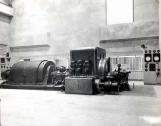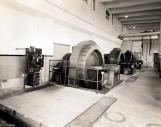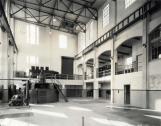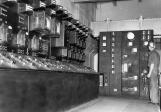1
My introduction to the steam plant was with the boiler cleaners. I showed up in the lunch room at the start of my first shift and there were a number of my fellow class-mates from school there. Soon a man came, lined us all up and marched us downstairs to a wire caged room. He handed us yellow rubber suits, gum boots and cannister masks, lined us up again and led us out into the steam plant, around a bunch of equipment and up a lot of stairs. At different floors he would pick out two of our group and tell them to wait beside a little hole in the side of one of the boilers. The rest of us would follow him like a bunch of yellow ducklings to another part of the boiler until we had all been assigned our holes. We squished our way through the little door and found ourselves standing on wooden planks running between two walls. There was not even enough room to turn around easily. Later I would learn these walls were actually "tubes" and the hard stuff between them was soot and sand and wasn't supposed to be there. Then the man yelled at us from outside to "listen up" and he passed in these long rod things with a hose attached to a valve at one end of the rod. "Now, that's high pressure water" he said. "Don't point it at anyone and don't point it at your feet or it'll take your toes off. Turn the water on as much as you can stand and blast all that stuff from between the tubes. I'll be back at coffee time."When he came back two hours later my hole mate and myself had figured out how much pressure to put on the lance and how to aim it at the soot buildup between the tubes without blasting off our toes or each others heads. We were soon covered in soot, drenched through the rain gear, and chewing grit despite the masks we kept over our faces (most of the time). After coffee break we were back in our holes again and by lunch I am sure we were all dreaming of a different career path.
Anonymous
3
From an interview with a Steam Engineer, 2nd Class, for "People of the White City"We used to have a lot of steam powered stuff around the mill that we don't anymore, that's something that's changed. One and two paper machines used to be driven by steam turbines. They had long line shafts with belts that ran up and over various parts of the machine. The saw mill used to have steam engines in them (electric motors and hydraulics run them now whereas they used to be steam engines and steam cylinders). Even in the steam plant, we used to have some of the fans driven by turbines. We used to have a steam driven air compressor and steam driven water pumps, and steam driven oil pumps. There were all kinds of little turbines and engines all around the place, and that's something that's gone by the book. Some of that was to do with the fact that the mill used to be so entirely dependent on its own power until hydro cam in (around 1957). They had electric boilers, and when the lake levels were high they would generate more electricity than was needed to run the mill and supply the town, and they'd put the excess energy and make steam for the mill. Of course the mill used to shut down on Sundays too, and the electric boilers (would supply the energy for the day). Conversely, they had a couple of condensing steam turbines so that when the lake levels got low they could conserve energy and burn fuel to generate electricity to take the load off the lakes.
5
Number 1 Generating Room, situated on the water side of the Old Grinder Rooms and served by No. 4 penstock, houses Number 1 Generator. This generator, mounted vertically, is connected to an I.P. Morris, Dominion Engineering water wheel, which operates under a normal average pressure of 63 lbs. per square inch. The maximum output of this machine is 12,000 Kilowatts, at 2,300 Volts. The power from No. 1 Generator is transmitted by heavy wires to the common bus in the main station.Number 2 Generator Room, situated between the Old Grinder Rooms and the Groundwood screen room, is served by Number 1 penstock and forms the central leg of our ree trunk. This plant is the main station, housing three generators mounted horizontally and connected to two Allis Chalmers and one Pratt Iron Works water wheels, which operate under a normal pressure of 63 lbs. per square inch. The Generators, Nos. 2, 3 and 4, generate at 2,300 Volts, No. 2 being capable of delivering 3,750 Kilowatts, while the capacity of No. 3 and 4 are 2,800 Kilowatts each.
Merton Golley
Men and Paper
Vol. 1, No. 45
March 22, 1947
6
GeneratorsCirca 1923
Powell River, British Columbia, Canada
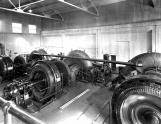 Credits:
Credits:P00181
Leonard Frank, photographer
7
When I started work, you didn't have a voltage tester, you had a box with carbon lights in it, and peek holes so you could see if the light was on, and you have two wires to go and measure, or to see if the lights would light up. We didn't have the stuff you have today to work with.Taped interview
People of The White City
9
Our Electrical Maintenance crew have their headaches in this phase of operating. Upwards of 1500 motors, totalling over 70,000 horsepower, ranging from ¼ h.p. to 4500 h.p. each, and in voltages from 110 to 6600, are required to operate the mill.It is the duty of our electrical maintenance crews to keep these in condition and to have a thorough knowledge of their characteristics and locations.
Powell River Digester
Vol. 26, No. 1
Jan-Feb 1950
10
Generator armature1920-1930
Powell River, British Columbia, Canada
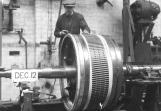 Credits:
Credits:P02373
Harland Engineering Company Ltd.
Jack Dice
11
The third and newest leg of our trunk is at Lois River. Here we find a building housing, at present, one 6,600 Volt Generator mounted vertically and connected to an I.P. Morris Dominion Engineering Co. water wheel, operating under a normal average of 160 lbs. per square inch. This generator, designated as Lois No. 1, delivers 18,000 Kilowatts and the installation of another unit, now underway, will be a duplicate of Lois No. 1 Generator and will give us another added 18,000 Kilowatts capacity.Merton Golley
Men and Paper
Vol. 1, No. 45
March 22, 1947
13
The power from this plant (Stillwater) is stepped up to 66,000 volts and transmitted by the "high line" to the Substation, just outside of the New Grinder Room, where it is transformed down to 6,000 volts. This substation feeds power to the New Grinder room, Screen Rooms, No 7 Paper Machine (and the future No. 8 Paper Machine), Nos. 2 and 3 electric steam boilers in the Steam Plant, lighting and power for Westview and lighting for certain parts of the mill. It is also tied in with the other generator rooms by means of a 6,600 volt tie line which feeds through transformers at the central station, stepping the power down to 2,300 volts, and from thence into the common generator bus in the main station.Merton Golley
Men and Paper
Vol, 1, No. 45
March 22, 1947

